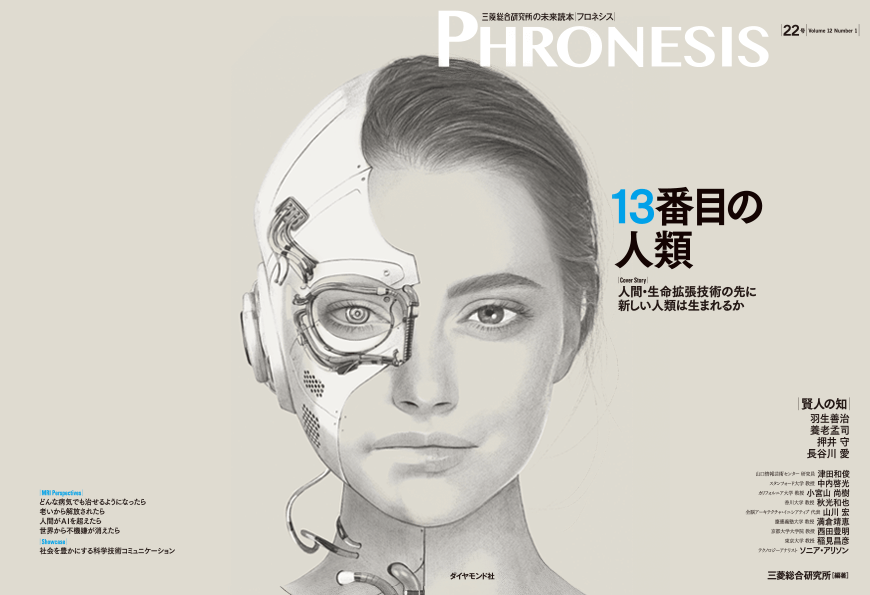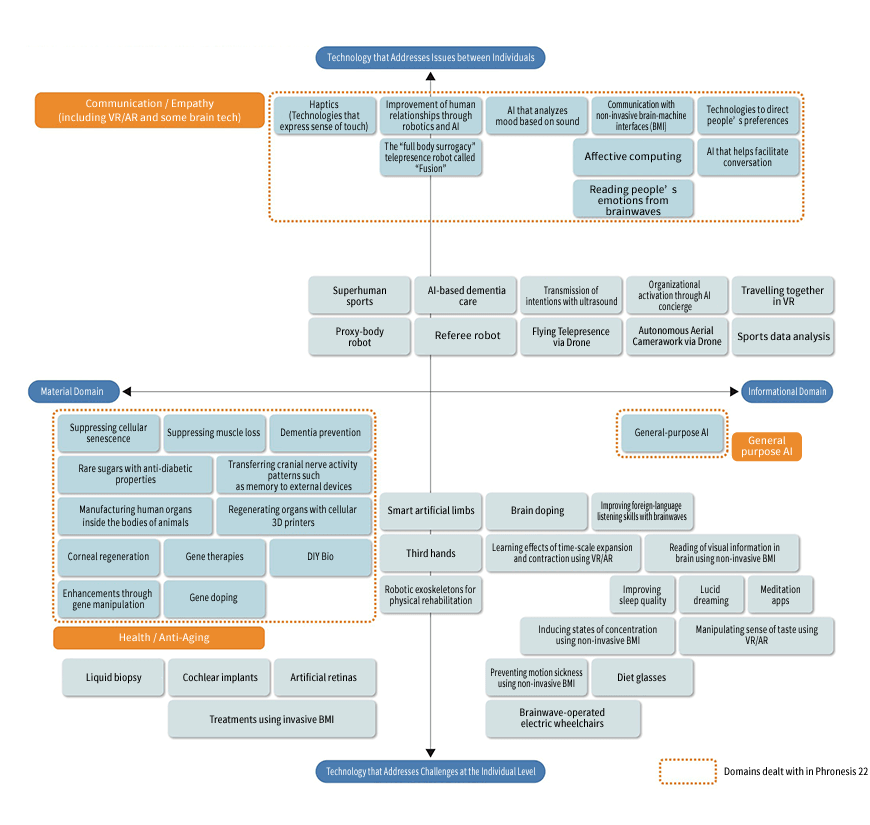
Publishing of Phronesis 22: The 13th Human Species
To commemorate the 50th anniversary of our founding, we, the Mitsubishi Research Institute (MRI), are conducting research to envision and enable the transition toward the ideal future society of 2070. The goal of the 50th Anniversary Research Project is to realize an abundant and sustainable society in the “10 Billion Population & 100-Year Life Era”. Ensuring the wellbeing of future generations is an important component of this goal.
The research project focuses on the role of advanced technology in achieving the desirable future world. The April 2020 issue of Phronesis, a publication by MRI that shares the results of its research & development activities, sheds light on human augmentation technologies as one such advanced technology.
This issue, titled The 13th Human Species, introduces inquiry by leading experts in fields related to human augmentation technologies and shares perspectives from MRI researchers. Below is a sampling of these insights.
We are the 12th Human Species
Our theory of the 13th human species is based on existing theories that our species, Homo sapiens, represents humanity’s twelfth evolutionary phase.
In this issue of Phronesis, we portray a forthcoming 13th human species, an evolutionary consequence of scientific and technological progress, from a variety of perspectives including changes in interpersonal relationships. The illustration on the cover is a conceptual rendering of this new human species, featuring a half-human, half-mechanical face with no cues as to whether it is definitively organic or mechanical, male or female. The image expresses humanity’s potential to transcend traditional boundaries.
The cover art was produced by Kei Meguro, an illustrator based in New York City. Meguro is also currently in charge of illustrations for serialized novels that appear in the morning edition of the Asahi Shimbun newspaper, and her photorealistic pencil portraits have brought her considerable acclaim on social media. She says that this project coincided with her existing desire to create a portrait with cyborg features. Although Meguro often accents her illustrations using a single striking color, in this creation she made the unexpected move of using white to accent the right eye—the effect drawing the viewer into the subject’s gaze.
Phronesis 22: The 13th Human Species

A Society Where Humanity is Highly Valued
In addition to visuals, the issue also features interviews with a diverse array of “Phronetic Leaders” with the aim of painting a textual portrait of this new humanity. “Phronetic Leaders” are forerunners in their respective fields and are utilizing their unique capabilities to envision the future world. Phronetic Leaders in this issue include: the famous shogi prodigy Yoshiharu Habu; the anatomist Takeshi Yoro; Mamoru Oshii, the director of Ghost in the Shell; the artist Ai Hasegawa, whose oeuvre includes many works of art concerned with the theme of life; and Sonia Arrison, who predicted almost ten years ago the arrival of a world in which average lifespans surpass one hundred years. The issue is also brimming with other contributions from pioneers in the field of human augmentation technology.
Habu believes that a particular strength of humans is their propensity to honestly maintain that a given shogi move, otherwise deemed erroneous and avoided by AI, might prove to be advantageous twenty moves later. However, this does not guarantee humanity’s superiority. Habu also mentions that while current AI lacks a sense of ethics, human beings lack an absolute sense of ethics and that “the emergence of AI seems to be raising questions about the essential nature of humanity.”
For his part, Yoro explains that “Human beings are able to sincerely enjoy the things that nature provides. However, it is difficult to feel heartfelt appreciation for artificial things.” Oshii also feels that “human beings have a natural state similar to animals. Trying to uncover that natural part of ourselves is important,” and explains that now more than ever, humanity should try to rethink how it will evolve.
The claims of these Phronetic Leaders echo the future society envisioned in the 50th Anniversary Research Project. The future world is all too often portrayed as one with growing disparities due to human augmentation technologies that extend healthy lifespan and the abilities of human beings. However, our discussions with Phronetic Leaders and other pioneers have painted an entirely different picture, one of a future society in which human augmentation technologies will usher both individual and societal wellbeing. As such, contemporary society must protect the welfare of not only the current 12th human species but that of the future 13th human species as well.
Applying Our Integrated Strength
Researchers at MRI investigating the potential of a future based on human augmentation technology apply a hypothetical perspective to their analysis that assumes that previously impossible feats become the norm. The cover story provides context for the rest of the issue by explaining the 13th human species concept in detail while offering commentary on how far human augmentation technologies have progressed to date.
Map of Human Augmentation & Life Extension Technologies Industry

Domains dealt with in Phronesis 22
In addition, individual articles examine in what ways technology will alter human beings in three areas: health maintenance & age prevention, AI, and communication. Columns are also interspersed throughout offering reflection on the relationship between science, technology, and ethics. Other features are segments that briefly introduce events happening around the world that point toward a hopeful future.
With such a wealth of content, instead of the typical 120 pages, this issue comes in at a hefty 152 pages and will be sure to reward the reader.
